Question
We are a millwork/cabinet shop. We are considering our first CNC and are looking at the Shop Sabre. Has anyone had experience with this machine? The model we are looking at is the 4896 with 5hp router, 5 collet tool changer, 20hp vacuum. Our primary reason for the machine is to cut parts for cabinets, but we will also use it for templates for various millwork. We've talked to the sales rep, and he seems very attentive.
Forum Responses
(CNC Forum)
From contributor O:
If you're going to do much solid wood machining, I would consider a much heavier-duty spindle.
It sounds like your salesman is trying to sell you a sheet nesting machine and embellish its capacity. Does this machine have a drill head, or will you be using a bit to make system holes? Again, be careful here. Using a small diameter bit to make a small hole can create a great deal of heat... shorten tool life and possibly create a fire. Slowing the spindle down can shorten the life of the spindle. You will need more torque at slower speeds. If your spindle is not designed for this (and I suspect it is not), it will damage the spindle.
It looks like it has a central ballscrew for the longest axis. You will have a problem with tolerances and repeatability, as the gantry will rack. Good machines have motors on each side of the gantry with error correction. If you are nesting, I do not see locator pins. The thing that makes a router most effective is how fast it will cut, and the speed in which you can load and unload the table. Pins help a great deal here. This is not an industrial machine. I believe the first ones of these were built in a garage.
Tech support is very important, especially if this is your first router. I would spend more time investigating the amount of techs that they have dedicated to answering the phone, both for technical questions and for software. My guess is that Shop Sabre attracts many first time users, and the need for more support will be higher.
The lack of a drill head also limits your productivity. You will more than likely be using a .125 bit to make 5mm holes. If you have a bookcase or many adjustable shelves, you will burn a lot of machine time. And if you cut MDF with these, your material can catch fire and be sucked through your spoilboard and into your dust collector. And again, with the heat generated, your tooling will dull faster and break because you cannot create a big chipload.
I am not trying to trash this machine. $13,000 is a great price to pay for a router. But if you are going to cut cabinets, you would do well to understand the limitations before you buy.
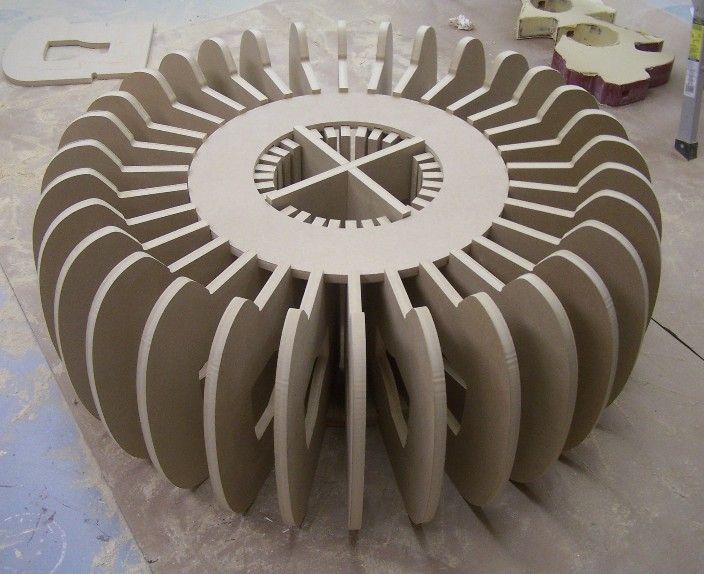
The shop next to the CNC fabricator processed old brick and heart pine salvaged out of old textile mills near Rome, Georgia. I walked over and saw the machinery they were using for this. My point is if you intend to process panels, this level of machine is fine, however if you intend to work lots of solid wood, then consider a much larger machine.
Also I was there to meet with prospective new CNC owners, some others who are waiting on machines, and those of us who have machines already. There was a great amount of training and sharing of techniques and such. Having the support of other owners was crucial in this for me and I am convinced it reduced my learning curve. CNC builders are as limited in their time as we are. They can be expected to make the machine work but may have some limitations as to teaching operations and software.
Contributor T, just what is that you're fabricating?
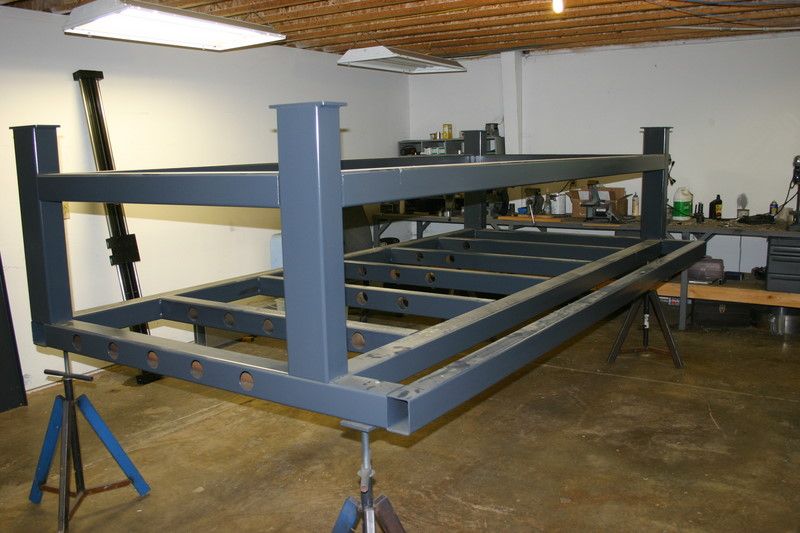
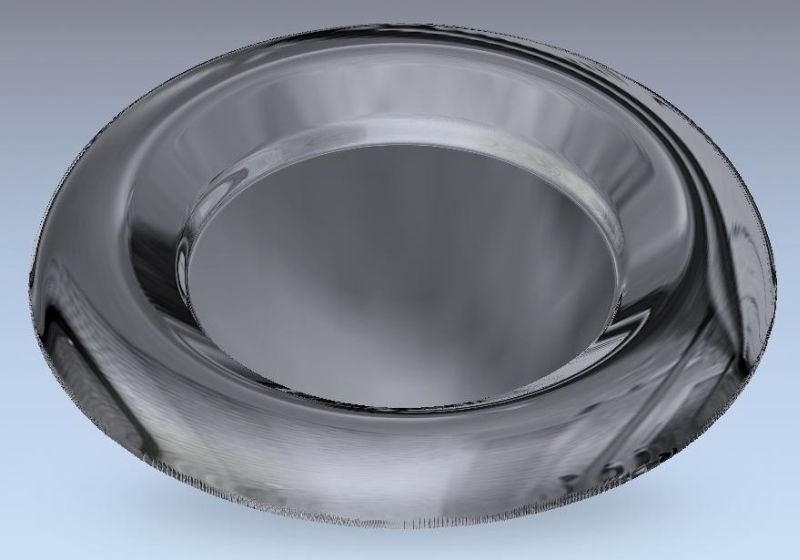
Let me say, it looks like he has done some fantastic things. It appears that he has a good market and has a great grasp of the software he is using. But don't oversell these machines. A sign cutter doesn't need to be telling a cabinetmaker that this is an adequate solution.
Sure these things can cut parts, but what are the additional costs involved? I can say that if parts like contributor T's are going to the edgebander, there will be problems. Edgebanding needs extremely tight tolerances to hold. This is an invitation for failure. Pay a skilled person to clean up what the router failed to do, or have a router that will produce parts correctly. You pay for this either way. And in a few years when this stick frame fails to hold tolerances, you have to decide whether to replace it (who would want to buy it?) and deal with the limitations, or step up to an industrial model.
These units should work great if you are going to hang a laser, knife, digitizer, plasma cutter, water jet on them. I am sure they will suffice with a small spindle for cutting thin plastic. But this is not a good solution for a cabinet shop thinking about cutting solid wood.
We started as installers for big plants and have stood right next to the heavy industrial machines and have seen them do their magic, however one of the biggest issues when I set out to buy my first machine was this - the internet was loaded with large machines from big production companies for sale after bankruptcies and foreign competition. The mid size machines were scarce and hard to find used. I also am not here to sell machines and will not post the name of my machine on this open forum. I am John Q. Customer and I need help from other small to midsize shops that are doing some of the last truly crafted work in this country. I don't want to pretend I am going to be a $2,000,000.00 + a year shop someday - been there done that! With just half or a little less than that, I can go home at 4:30pm, have very little employee turnover, and make a decent living.
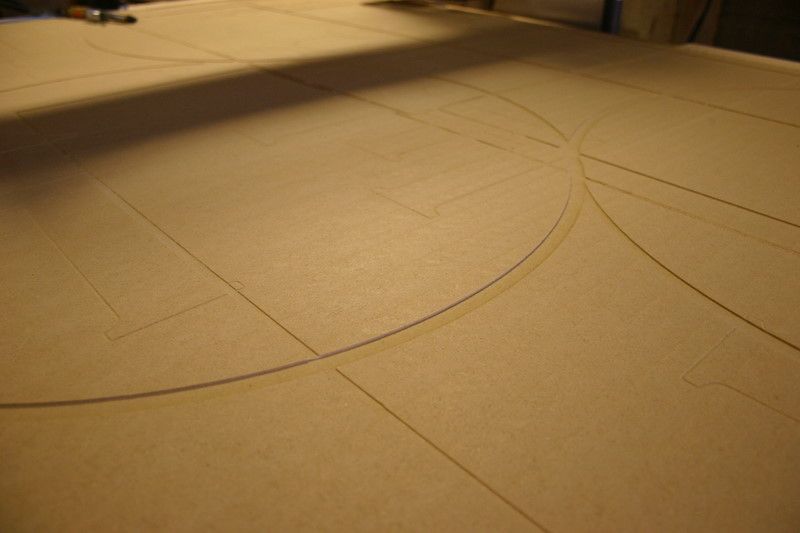
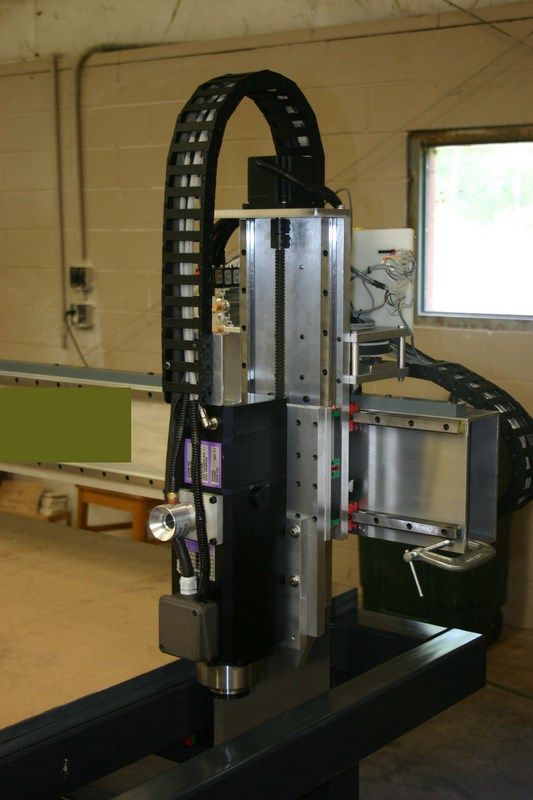
Here is the cut. Ran the word "WOODWEB." Software is vcp. 1/4" downcut at 200 ipm.
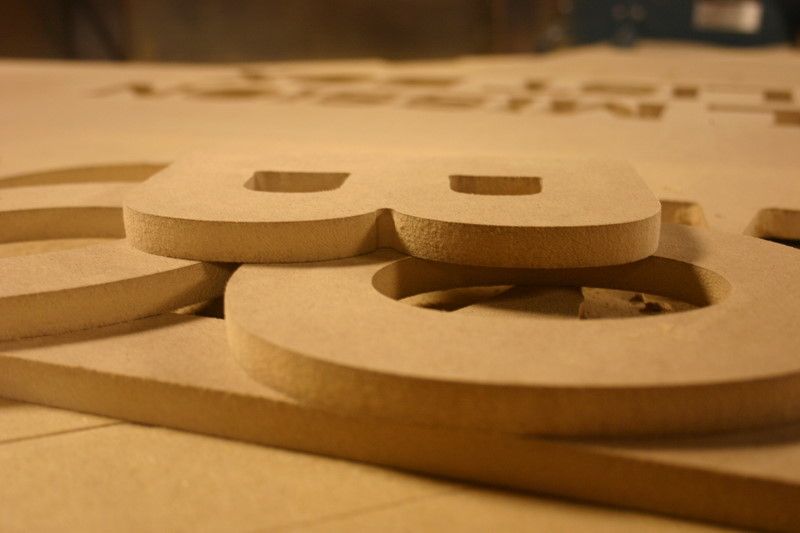
I am looking for a greater vacuum for my new machine, and I did get a fabulous deal on my first machine. Found out real quick it was a better 2d process machine and ordered another. I was being almost harassed by several CNC companies to buy their machine as "no one else has figured it out the way they have."
CNC has been fun for me and I have found other revenue streams for it (I am on my third apartment complex for signs). Don't buy the first CNC you see - it's a substantial investment of time and money (wait till we get into bits and software!) but it ain't voodoo and technology is making it more affordable all the time.
I have been told that the major damage I will do to my spindle is at warm up when first starting the spindle daily. We set ours on lowest setting and run for 4-7 minutes before starting to run any files.
The cfm requirements with an electric fan for my spindle are 300, and for compressed air are 8.75 as the venturi is an air amplifier. Again, in our line of woodwork these routers are not running shifts - there are days they don't even get cranked up.
We recently did a cabinet replacement for probably one of the largest pasta producers in the nation. We replaced the cabs in the machine control rooms and had to do this while it was all running. We got to watch machines running three shifts and if that were the case, I would definitely be involved with much larger routers.
I have been to the Shopbot facility and have seen the machines in action and they cut fine as long as you have the right tool, the right speed, and the right rpm along with the right vacuum. I suspect the part may have slid during the final pass from lack of hold down.
We have a Thermwood shop machining our parts right now and I can tell you that smaller parts coming off that 100k machine often show chatter marks too and it isn't due to spindle or gantry flex, but the part moving when the vac isn't strong enough.
The smaller routers certainly aren't going to hog out 10/4 lumber in one pass with a perfect profile, but they also aren't going to put your business in jeopardy if they sit idle for a few days once in a while.
I certainly wouldn't buy one if I wanted to nest sheets 3 shifts a day, but I wouldn't buy a 150k machine if I was only looking to replace 1 or 2 employees and be able to do custom, one-off things that require accuracy and flexibility.
Small parts are problematic, especially if you have many pieces on a sheet, and you lose vacuum. There are, however, things that can be done to reduce the chances of the parts moving. The pieces that the questioner cut should be smooth, especially in MDF. I hear you making excuses for this, saying that you get the same thing off a 100K machine. Let me say that if you are getting parts like this off a 100K machine, you either don't know what you are doing or you have a bad machine. And price is not always a good indicator of the quality of a machine.
Too often people are willing to buy the pitch that if you spend $8K to $13K you can have parts as good as machines costing much more. It is simply not true. If we are talking about cutting vinyl, maybe. But these are high-end hobby grade machines. You can get similar quality assembling from a kit. Stick frame, no vacuum pump, no drill head, small spindle, light duty gantry... That is how they save thousands making these machines. And as a user, you are forced to deal with its limitations. This costs time. Time is money. Your router may need to sit idle in a small shop for a few days as you try to clean up your parts to get them to fit correctly.
There is a big difference between a sliding table attachment for a Unisaw and an Altendorf. Price is certainly a big difference. Precision, accuracy, and ease of use are others. It wasn't until I got the slider that I realized how much the Unisaw with sliding table was costing me.
I stated that we have parts machined by a shop with a Thermwood router. This shop machines parts for themselves and other shops and they do a great job and they have plenty of experience, but when cutting parts as small as the ones above for us, they still have trouble having enough vacuum to hold the part without moving even if they skin them and at times we get chatter marks or the bit cuts into the part as it slides around.
Without mechanical fastening or jigs, this can happen with any router, plain and simple. It could also be caused by bit flex if the diameter is too small or the feed rate is too high. Also, to address your comment on the drill head, yes, they are nice. They speed up production and are certainly a worthwhile option. That said, the shop we outsource our machining to has no drill head. They run all of their hole drilling with just the spindle. It can be done. It may not be the perfect solution for everybody, but that doesn't disqualify the shops without them from being viable.
Shop Sabre does, if you want, have the option for an air drill if you so choose.
When you are ready to buy your router (you seem like a good candidate), take your own work with you. Let them run it through their software, and let them cut your parts. And just to step it up a notch, let them cut melamine, solid wood, and even plastic. Examine the quality of the cut. It is important and valuable. I guarantee you that these machines will start to show their capabilities when they work towards their capacities.
It amazes me that someone would spend 100K on a router and not have a drill head. And they didn't even pay for software! The cost in tooling alone would pay for a drill head, not to mention time spent waiting for a spindle to cut circles.
To add to your experience, I would spend some time in shops that are more production oriented. Thermwood pushes blind dados because it fits their machines. You don't have to have a drill block. All you have to do is run that silly spindle to death. Who needs adjustable shelves? Just run a dado and use a fixed shelf. And we certainly wouldn't want to suggest confirmats or dowels if we are pushing machines without drills. Thermwood is good about getting people in the door with as little money as possible. They provide a very good software package for free, and offer packages that are very inexpensive. It is not until you have parts moving that you realize that they undersold you on the vacuum pump. And then you realize that you waste a lot of small diameter bits making holes because you cannot accelerate fast enough to get a decent chip load making small circles for drawer guides and adjustable shelves. Not to mention the time it takes to machine these holes instead of pecking them 5 or more at a time.
Can you get into a machine cheaply? Yes. Do you remember the Yugo? Every time someone tries to sell you a machine by comparing it to a larger more expensive machine, beware. It cost less for a reason. At a certain point, many industrial routers are similar in quality. The price difference is in the quality of the components and the support you will receive. Great manufacturers will have a good response time, an appropriate amount of techs per machine, great retention rate in their support staff, and a large percentage of repeat customers. Other manufacturers expect you to help pay for their slick marketing, and excessive layers of support and administration. A good customer will be able to sort through who is solid and who is shine.
Contributor M, nice points and well thought out. Just remember, not every shop has an identical business model. Some are geared towards systematic high volume production and others are geared toward filling a niche of making specialty items and trying to do it with accuracy that is higher than can be done with clamps, routers and table saws, etc. as has traditionally been the case.
With a high dollar machine, a dedicated doweling machine, case clamp, etc., you can certainly outperform any light duty machine hands down. However, do you think it is a good business model for a 1-2 man shop that specializes in non-systematic cabinetry and custom one-off pieces for designers to invest that kind of capital into a machine that may sit for days on end without being used? How would you arrange the financing for that type of investment?
I have done a lot of investigation and I do feel that I have a pretty good handle on who uses what in businesses that are similar to mine and where we are headed. I have also tried to work with a large scale component manufacturer to see whether they could supply the parts that I need the way I want them, and the bigger they are, the more inflexible they are. When I went to this big component company and asked them to give me a price on the cabinets and the doors as designed by the designer I work with, I was told they couldn't do it. Why? Because they need to keep the machine fed and they have no time to be creative or flexible. They do what they do very, very well, but they can't do what I need them to, so in that case, what good is all of the software and machinery?
I also needed a pair of custom solid wood pediments cut for a project I worked on last year and I went to a few different production shops with dedicated draftsmen who declined the work. The reason was that the request was not going to be cost effective. So I went to the ShopBot forum and had one person draw the file for me in one part of the country and send the file to another SB owner in the state who downloaded the file and cut the parts for me very economically and very precisely. So what good is all of that power and capacity if you can't afford to utilize it in the real world?
And the idea that you must be a high volume shop to afford an industrial router is simply not true. When I started looking into a router, I had a fixture we were producing. I did a time study and determined that it would take 18 days to machine these parts. We were using a slider and a construction boring machine. With a router, it would have taken 2 days. The money I saved in labor alone would have paid for the payment that month. Yes, you can use the router for two days out of the month and still make money. Three years ago, the break even point for us was 20 sheets. If we machined 20 sheets, we would make the payment.
And late last year, the same thing. We had parts to make. When we did them by hand, it would take 5 guys 18 days (I don't know what it is about 18). But when we did a double-sided nest, 1 guy did it in 2 1/2 days. Do the math. 5 guys at say $10 for 8 hours a day, for 16 days... $6400? My 5x12 Onsrud with 40hp vac, drill head, 18 hp spindle, 12 position tool changer, and C-axis is less than half of that. And it is a whole lot more accurate than any guy in my shop.
I guarantee I could cut your parts and still make money and save you money. These guys who are turning down your work are doing so out of a business model. They have a very narrow niche and that is where they want to be to maintain high profits. And other shops are structured so that they have a tremendous amount of support staff geared to larger projects. And no, it doesn't make sense to tie up a lot of resources to make a door or small cabinet. But that doesn't mean that small shops cannot afford industrial routers.